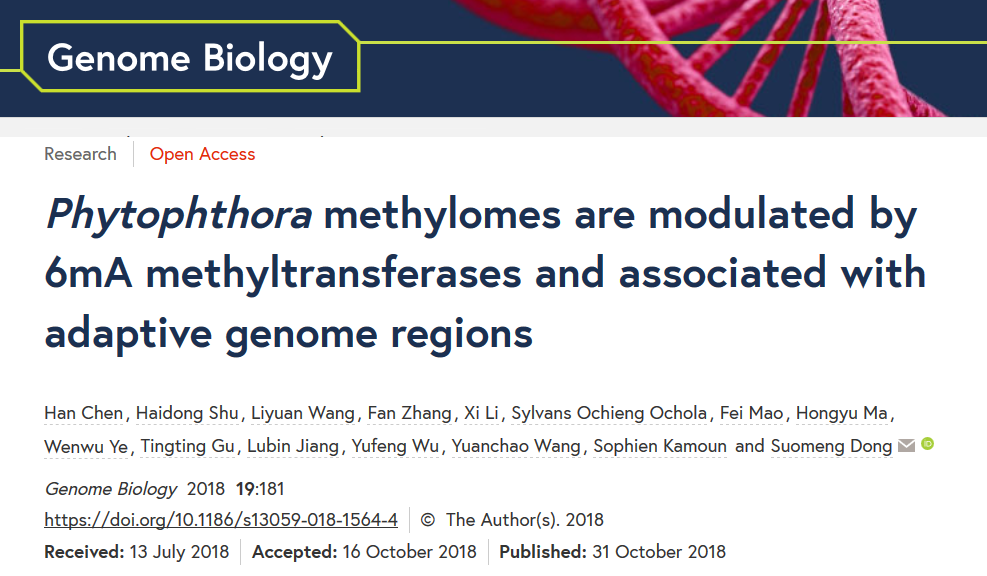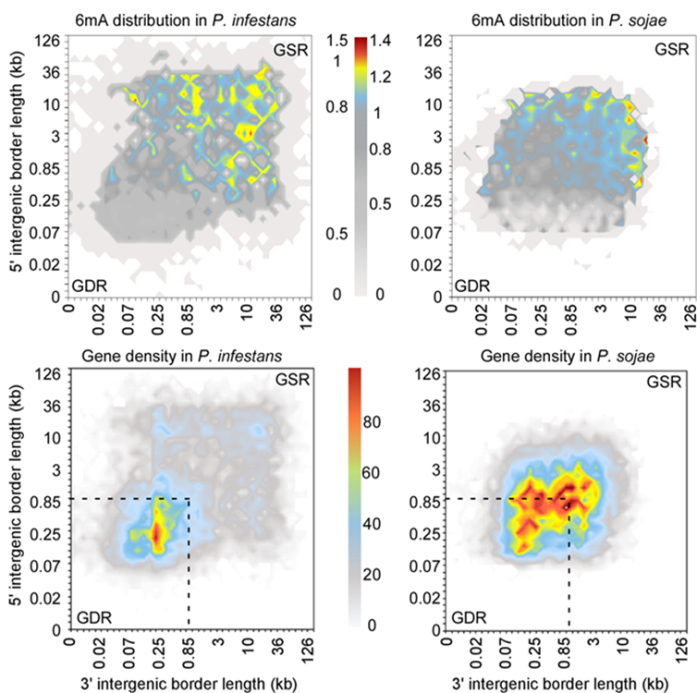Oomycetes include many devastating plant pathogen species belong to Phytophthora,downy mildew, Pythium and Albugo. They severally threaten global food security and natural ecosystems by causing major diseases in agriculture, forestry, ornamental andrecreational plantings [1]. One of the most notorious examples is Phytophthora infestans, the causal agent of potato late blight disease which sparked the Irish famine in the 1840s, resulting in starvation and migration of millions of people [2]. Besides the aggressiveness, these pathogens have the amazing capability to breakdown resistance of crop cultivars and adapt to applications of fungicides [3]. Exploring molecular or genomic basis of Phytophtora adptability is required for susteinable disease management.
It’s widely accepted that sequence ploymorhphisms in important loci such as Avr3c and epiC1 drives successful Phytophthora adaptation on host immunity system [4-6]. However, increasing evidence showed that the roles of epigenetic regulation in shaping the host adaptation are underestimated [7-9].But not much knowledge in epigenetic adaptation of this pathogen is accumulated.

A research group in Nanjing Agricultural University recently published the research article titled “Phytophthora methylomes are modulated by 6mA methyltransferases and associated with adaptive genome regions” in Genome Biology. This paper decoded the first draft of oomycete methylome and the underlying regulation mechanism of DNA methylation [10]. These exciting results are expected to spark novel strategies for crop oomycetes disease control.
This research systematically studied two Phytophthora genomic DNA methylation (5mC and 6mA) on important crop pathogens P. infestans and Phytophthora sojae. There’s no detectable 5mC in two genomes, and methyltransferase involved in 5mC methylation was also not found. But 6mA methyltransferases are expanded in Oomycetes genomes, 6mA is associated with lowly expressed genes, and enriched in transposons and fast evolved regions. Moreover, transposons and pathogenic genes are activated in 6mA methyltransferases knockout mutant. These results pointed out potential roles of 6mA in maintaining plant pathogen pathogenicity variation and shaping genome structure. The future insight into methylomes broaden horizons of oomycetes variation and provide a starting point to further pathogenicity and drug resistance research.

This research is leading by Prof. Suomeng Dong and PhD student Han Chen from Nanjing Agricultural University. Faculties from Institute of Pasteur of Shanghai and the Sainsbury Laboratory (UK) also participated in this study. The Project was supported by the National Natural Science Foundation of China and Thousand Talent Program for Young Outstanding Scientists.
Reference:
Jiang RH, & Tyler BM. (2012). Mechanisms and evolution of virulence in oomycetes. Annual Review of Phytopathology, 50(1), 295-318.
Great Famine (Ireland). https://en.wikipedia.org/wiki/Great_Famine_(Ireland).
Dong, S., Raffaele, S., & Kamoun, S. (2015). The two-speed genomes of filamentous pathogens: waltz with plants. Current Opinion in Genetics & Development, 35, 57-65.
Dong S, Stam R, Cano LM, Song J, Sklenar J, & Yoshida K, et al. (2014). Effector specialization in a lineage of the Irish potato famine pathogen. Science, 343(6170), 552-555.
Huang, J., Chen, L., Lu, X., Peng, Q., Zhang, Y., & Yang, J., et al. (2018). Natural allelic variations provide insights into host adaptation of Phytophthora avirulence effector PsAvr3c. New Phytologist.
Armstrong, M. R., Whisson, S. C., Pritchard, L., Bos, J. I. B., Venter, E., & Avrova, A. O., et al. (2005). An ancestral oomycete locus contains late blight avirulence gene Avr3a, encoding a protein that is recognized in the host cytoplasm. Proc Natl Acad Sci U S A, 102(21), 7766-7771.
Vleeshouwers, V. G. A. A., Raffaele, S., Vossen, J. H., Champouret, N., Oliva, R., & Segretin, M. E., et al. (2011). Understanding and exploiting late blight resistance in the age of effectors. Annual Review of Phytopathology, 49(1), 507.
Qutob, D., Chapman, B. P., & Gijzen, M. (2013). Transgenerational gene silencing causes gain of virulence in a plant pathogen. Nature Communications, 4(1), 1349.
Pais, M., Yoshida, K., Giannakopoulou, A., Pel, M. A., Cano, L. M., & Oliva, R. F., et al. (2018). Gene expression polymorphism underpins evasion of host immunity in an asexual lineage of the Irish potato famine pathogen. BMC Evolutionary Biology, 18(1), 93.
Chen H, Shu H, Wang L, Zhang F, Li X, Ochola S. O., Mao F, Gu T, Jiang L, Wu Y, Wang Y, Kamoun S & Dong S. (2018). Phytophthora methylomes are modulated by 6mA methyltransferases and associated with adaptive genome regions. Genome Biology 19:181.
